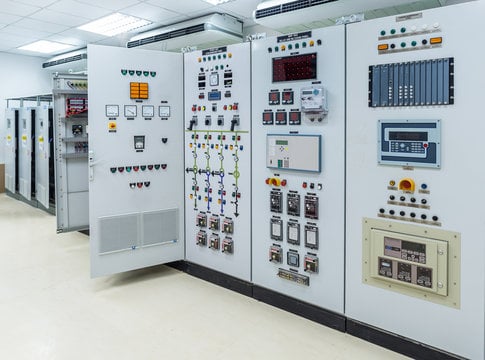A power system analysis is intended to provide your facility with a power system that is safe, efficient, and dependable under normal and abnormal operating conditions. The objective of a power system analysis is to grasp how a system will perform in different configurations and the effects of disturbances such as the switching of capacitors, the start of a big motor, and arc flash incident energy. To ensure the reliability of safety equipment in the event of a short circuit or other breakdown, it may be required to investigate the power system. Research into power systems is essential for sustaining a constant and reliable energy supply. A well-designed power system ensures dependable operation and maximizes plant availability in any operating scenario. Poorly built systems cause outages, defects, inefficiencies, and a decline in security.
The majority or all the below sub-studies may be incorporated into an average power system analysis:
- Evaluation and analysis of load flow
- Short circuit research and assessment
- Relay coordination evaluation
- Evaluation & research of arc flash danger
- The exploration of harmonics
- Examining fluctuations and dynamics
- Explore the universe
In this blog post, we will examine the first three studies to comprehend their underlying concepts and methods.
Study and Assessment of Flow of Load:
A load flow analysis investigates an electrical network to determine the power flow. It aids in evaluating the operating state of the power system, as well as the quantity of active and reactive power generated, losses, voltage, current, and power factor.
The load flow analysis included the subsequent three steps:
- Simulation of power system components and networks
- The introduction of load flow equations
- Utilizing numerical approaches to solve load and flow equations.
There are three computation methods for power system data:
- The Gauss-Seidel System is one of the most used analytical procedures. This method has the advantages of being simple to implement, needing little computer resources, and accelerating the completion of the task. Due to the delayed convergence, additional iterations are necessary. The number of iterations grows in direct proportion to the number of buses.
- The Newton-Raphson approach makes use of quadratic convergence, which is advantageous in complicated settings. This approach takes fewer iterations to achieve convergence, and so utilizes less computer resources. Less difficult elements, such as controlling transformers and slack bus selection, contribute to its better accuracy. Programming may be tough and calls for a considerable amount of computer memory.
- The Fast Decoupled Load Flow System is an additional load flow analysis approach (FDLF (Fast Decoupled Load Flow)). This approach employs less computer memory, which is its major advantage. The processing speed is five times quicker than the Newton-Raphson approach, making it the preferred solution for real-time power grid management. This program can only be used under specific circumstances. Therefore, it is more difficult to adapt it to other challenges in the energy sector, such as flow or system protection.
Short Circuit Analysis and Investigation:
A short circuit analysis will analyze at least one of the following types of short circuits:
- Line-to-line fault, which happens when simultaneous failure of two phases
- In the event of a single line-to-ground failure, only one phase contacts the ground.
- Double line-to-ground fault, which occurs when both phases and the ground are simultaneously shorted.
- Three-phase fault distinguished by simultaneous shorting of all three phases
Once the issue is established, it will be easier to create a single-line diagram of the power distribution system. Calculate short circuits using the produced single-line diagram and an impedance diagram with numerical values for the utility source, transformer, and conductor in relation to each component’s usable voltage.
The calculated values include the short circuit current, the transformer multiplier, and the full-load amps. It is crucial to compare the collected data to the equipment ratings to verify that the power distribution system is outfitted at various locations with the required safety measures to prevent danger and downtime.
Analysis of relay coordination
Coordination systems enable rapid, dependable, and selective relay operations to isolate the problem, making relay coordination a crucial component of the architecture for power system safety. Coordination analysis determines the extent to which overcurrent prevention devices are essential to the power system. In addition, it helps strike a balance between equipment security and restricted system function by determining the correct requirements, configurations, and dimensions.
To model the system, data-collecting activities are carried out using software for power systems, such as ETAP (Electrical Transient Analysis Program). After completing a short circuit analysis, the fault currents are measured at each electrical site. The impacts of system equipment failures are minimized by choosing and calibrating the protection devices. Comparing the time-current characteristic curves of the protective device assists in the localization of failures in coordination. As necessary, changes are made to ensure that protective devices operate reliably and selectively.
The Advantages of Power System Analysis Include:
- A boost in the electrical grid’s dependability.
- The use of equipment with the appropriate power rating.
- Increased safety and less electrical hazard.
- Compliance with electrical installation regulations and codes.
- Recommendations for alternate approaches to improve the system’s performance and dependability.
- Documentation of the power system’s present status in preparation for forthcoming inspections.
CareLabs provides Load Flow study & analysis, Short Circuit study & analysis, and Relay coordination analysis to monitor the voltage at various buses as well as the actual and reactive power flow between buses, analyze the system under various fault conditions, and determine the system’s resilience to minor and major disturbances. To assess your company’s power infrastructure in the Netherlands, please contact us or get a quotation. One of our customer service employees will reply within twenty-four hours.




